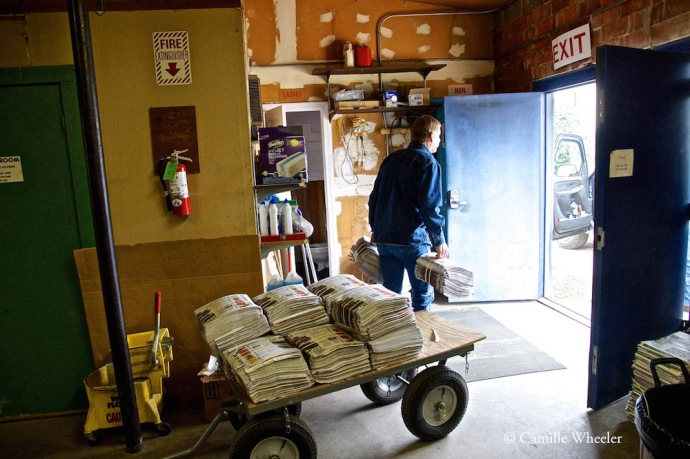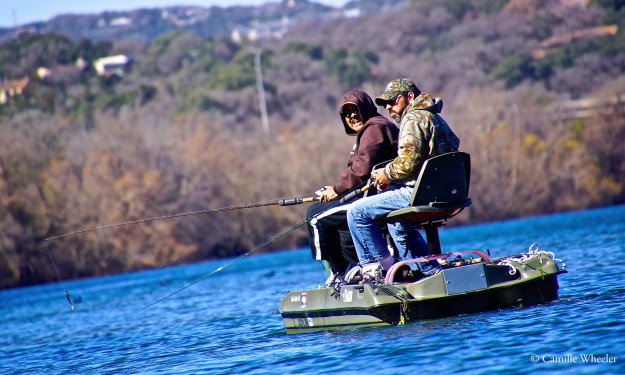A gorgeous photo from http://naturehasnoboss.com:
Taking a break from patrolling the marsh a Northern Harrier enjoys the morning sun while hidden in the reeds. Mackerricher State Park, Northern California.
Source: Northern Harrier

A gorgeous photo from http://naturehasnoboss.com:
Taking a break from patrolling the marsh a Northern Harrier enjoys the morning sun while hidden in the reeds. Mackerricher State Park, Northern California.
Source: Northern Harrier

Route drivers deliver The Rockdale Reporter every Wednesday within a 30-mile radius of the Central Texas town.
In Rockdale, Texas, about an hour’s drive northeast of the state capital city Austin, the Cooke family has owned The Rockdale Reporter since June 1, 1911. This award-winning community newspaper, established in 1893, technically is a Thursday publication. My write-up about my trip to The Rockdale Reporter was featured in “Wednesday’s Headlines,” a new, and very smart, offering from Bob Ramsak, a reporter, photographer, and blogger at http://www.pirancafe.com:
http://www.pirancafe.com/2016/01/21/wednesdays-headlines-3-small-beautiful/

The Rockdale Reporter — technically a Thursday publication for subscribers who receive it by mail — is delivered for same-day readership every Wednesday in Central Texas. To learn more about The Rockdale Reporter, and community newspapers in Texas, read my 2014 magazine story at www.texascooppower.com/texas-stories/life-arts/success-stories.
Every Wednesday, around noon, a truck delivers thousands of copies of The Rockdale Reporter straight to the newspaper building’s back door from nearby Bryan in Central Texas. Fresh off the presses of The Eagle newspaper in Bryan, where it is printed, The Rockdale Reporter is immediately readied for same-day delivery to a variety of locations within a 30-mile radius.

Production Manager Shannon Whorton uses an electric label dispenser to prepare newspapers for mailing.
On Wednesday, January 20, 2016, a truck delivered 4,830 copies of The Rockdale Reporter to the newspaper. While Production Manager Shannon Whorton prepared 2,000 newspapers for mailing, labeling the papers with an electric dispenser and tossing them into plastic tubs that co-worker Cliff Dungan carried to a van, the rest of the newspapers were delivered by regular drivers for same-day readership.

Cliff Dungan, a printer, photographer, and fix-it man for The Rockdale Reporter, carries a tub of just-labeled newspapers to the newspaper’s van for delivery to the post office next door.
Dungan, who would eventually fill the newspaper van with almost 20 tubs, jokes that it takes more gas to start the van than it does to drive it to the loading dock of the post office next door.
But week after week, driven delivery to the post office is necessary: With a circulation of almost 5,000, The Rockdale Reporter is reaching a lot of readers throughout Central Texas. The newspaper’s staff boots-on-the-ground reporting gives readers the vibrant journalism so necessary for the health of any town or city.
So essentially — save for the 2,000 newspapers scheduled for Thursday mail delivery — The Rockdale Reporter is a Wednesday paper. Sure enough, about an hour after the delivery truck left, people were showing up at the newspaper’s front door, plunking coins into the old-fashioned newspaper rack and getting their weekly, Wednesday, journalism fix.
The new series continues with 19 contributors filing 25 images from 20 cities in 13 countries. The theme? Small is beautiful.

Against the backdrop of the tall buildings of downtown Austin, a Double-crested Cormorant tolerates my presence at Lou Neff Point on Lady Bird Lake.
Every November, I start watching for the arrival of Double-crested Cormorants to Austin’s Lady Bird Lake. On the occasional stroll around the lake’s hike and bike trail, I thrill at seeing the cormorants dry their wings while perched high in bald cypress trees at the water’s edge. From a variety of vantage points along the trail, I love watching these big, athletic birds ride the small swells in the middle of the lake and then dramatically plunge beneath the surface.
When driving across any one of the lake’s bridges at dusk, I crane my neck, watching for the trademark, almost V-shaped formations of cormorants flying home for the night to their tall-tree roosts. The cormorants’ wings beat impossibly fast, as if the birds are competing in a race that can never be won.

From my kayak, I thanked this cormorant for giving me several different views at Lou Neff Point on Lady Bird Lake.
For me, the cormorants signal a solemn change of season; a time of reflection and pause. My heart plunges to a familiar melancholy depth when the first cormorants arrive. Strong swimmers, they survive by diving for fish. Otherworldly in appearance, the cormorants lend a prehistoric feel to Lady Bird Lake during their winter stay.
I recently tried photographing cormorants from the hike and bike trail. I was not successful. I realized I had to get closer: I had to get on the water, with the birds. So this past Friday, on January 15, I rented a kayak from the Texas Rowing Center on Lady Bird Lake, determined to sidle up beside cormorants and other birds and wildlife on the water.
Considering this was only my second time in a kayak (my timid maiden voyage came on a summer day several years ago at the Texas Rowing Center), I was nervous for me, and for anyone else on the water.
Grappling with my camera gear, worried about a bum knee, and horrified at the very real possibility of unceremoniously dunking myself in the lake, I slid on my butt from the wooden dock into my one-person kayak. To the stoically quiet employee who assisted me: Thank you for not laughing. At least not in front of me. Fortunately, save for a mother and daughter who pushed off in a double kayak from the Texas Rowing Center dock just moments after my departure, the late-morning lake was largely void of human activity.
More than two hours later, riding the calm lake alongside cormorants, American Coots, and a wide variety of ducks including scaups and Buffleheads, I had forgotten to be afraid.
I wasn’t graceful, but the lightweight kayak was. The slender boat allowed me access into many a tight spot.
Time and again, as I skirted the shoreline, edging up next to egrets and turtles, the latter strung out on small limbs like beads on a necklace, the forgiving kayak got me out of jams. I banged the boat’s nose into low-hanging branches. I scraped tree roots. I hung up on the lake’s gravelly bottom in shallow water. But with the kayak’s double-bladed paddle I found easy to use, I learned to push myself back into deep water.
I learned, sort of, how to stop the kayak, or at least slow my progress long enough to get better views of wildlife lingering at the water’s edge as I drifted past.

For me, Wood Ducks — male Wood Ducks, that is, as seen at left — are the Painted Buntings of the water. They’re stunningly gorgeous.
I learned that reclusive Wood Ducks don’t take kindly to clumsy kayakers coming up on them, especially at much too fast a pace.
I learned, from two fishermen on a small boat, below, that the bass were biting.

I’ve always wondered what kind of fish live in Lady Bird Lake. These fishermen happily told me of one species: bass.
I observed, at the corner of Lou Neff Point, that cormorants sunning themselves on low-slung limbs will let you take lots and lots of pictures as long as you don’t come too close — say three feet while cradling the kayak paddle in your lap, grasping a branch knob with your left hand, and somehow holding and focusing the camera with your right. For sure, that scenario is enough to make any cormorant, such as the one that tolerated me for a good 10 minutes, flee the branch for the safety of the water.

Weary of my close-up photography, this cormorant finally took to the water beside Lady Bird Lake’s Lou Neff Point.
I can’t wait to go kayaking again on Lady Bird Lake. I’m eager to learn how to step into the kayak, with the elegant confidence of an egret, instead of sliding in on my behind. I can’t wait to gently rock on the water in the middle of the lake, paddle resting on my lap, as I watch the wild, wild life fly, and swim, all around me.
The new series continues with 22 images from 17 contributors from 18 cities in 13 countries. The lead? Still remembering Bowie.
Source: Wednesday’s Headlines #2
Blogger Bob Ramsak unveils the first edition of “Wednesday’s Headlines” (www.pirancafe.com/2016/01/07/wednesdays-headlines-1): a weekly international collaboration and compilation of newspaper-themed images shot on the same day across the globe. The inaugural collaboration, as selected by Ramsak, features newspapers from Chicago; Washington, D.C.; Portland, Oregon; Durango, Colorado; Austin, Texas; Montpelier, France; Vienna, Austria; Slovenia; Amman, Jordan; Mumbai; Beirut; Punta Arenas, Chile; and Athens, Greece.
Ramsak is currently blogging from Ljubljana, Slovenia at http://www.pirancafe.com.
Source: Wednesday’s Headlines #1